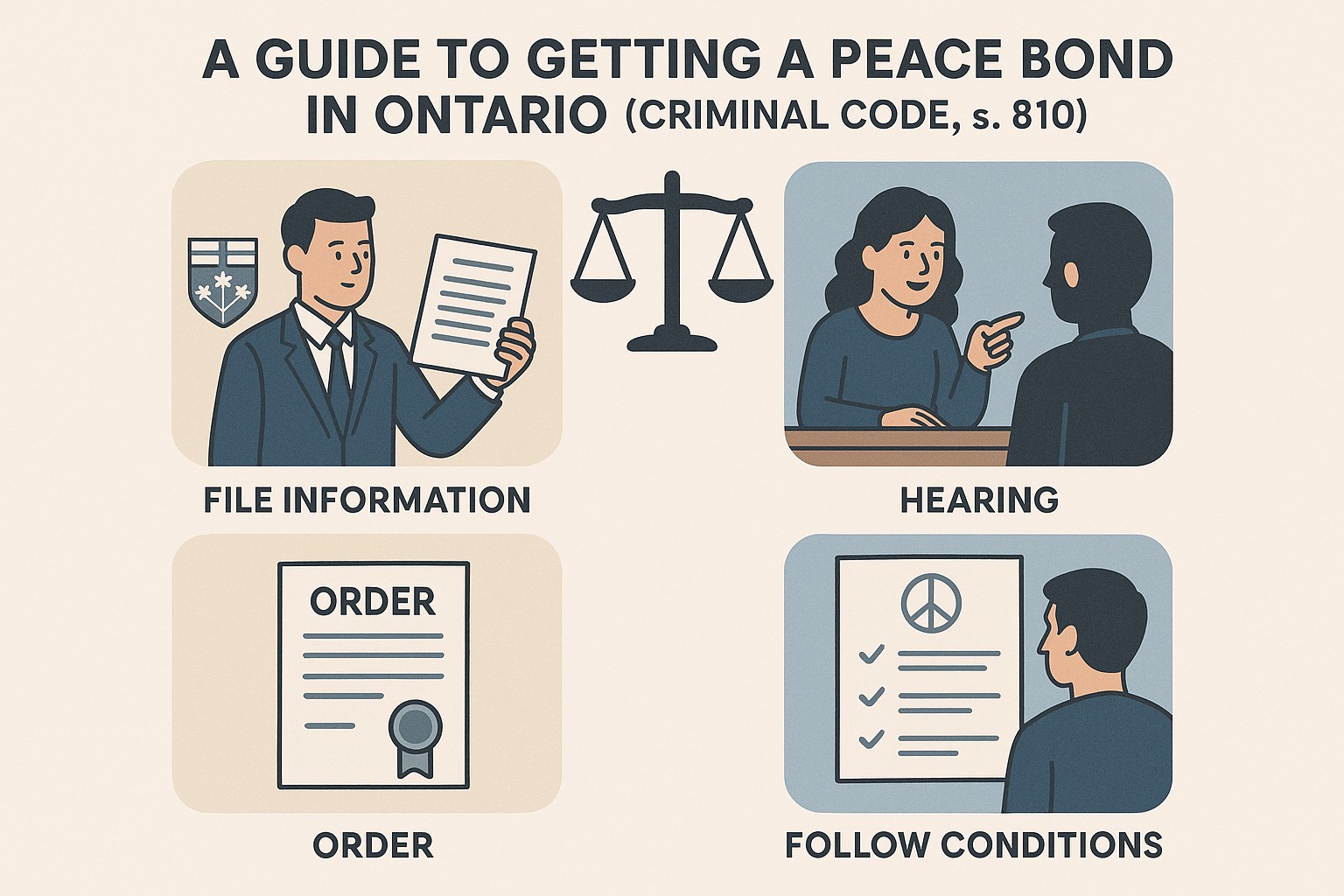A Guide to Getting a Peace Bond in Ontario (Criminal Code, s. 810)
A **section 810 peace bond** is a powerful tool in Ontario's criminal justice system that allows you to get a "no-contact" and "keep-the-peace" order against someone you fear, even if no criminal charges have been laid. Our guide explains the step-by-step process, from laying a sworn "Information" (Form 11) before a Justice of the Peace to the final court appearance.

A section 810 peace bond, often initiated by providing information under Form 11 of the Criminal Code, is a preventative criminal court order designed to keep you safe when you have a reasonable fear that another person may harm you, your family, or your property.
Crucially, as you noted, no criminal charge needs to have been laid for you to seek one. It is based on a fear of what might happen in the future.
This guide explains what a peace bond is, how it differs from a family law restraining order, and the step-by-step process for obtaining one in Toronto.
What is a Section 810 Peace Bond?
A peace bond is a formal promise made before a criminal court judge or justice of the peace. The person you fear (the "defendant") agrees to abide by specific conditions for a set period, typically 12 months. It is not a criminal conviction or a finding of guilt. It is a preventative measure.
To get one, you (the "informant") must show that you have reasonable grounds to fear that the defendant will commit a specific criminal offence, such as:
- Causing personal injury to you or your family.
- Damaging your property.
- A sexual offence (in the case of a s. 810.1 peace bond).
Peace Bond vs. Family Law Restraining Order: Key Differences
While both offer protection, they operate in different legal worlds.
Feature
s. 810 Peace Bond
Family Law Restraining Order
Court System
Criminal Court (Ontario Court of Justice)
Family Court (Superior Court or OCJ)
Who it's against
Anyone (neighbour, ex-partner, co-worker, stranger)
Usually a spouse, former spouse, or other parent
Legal Basis
Reasonable fear of a future criminal offence.
Broader grounds, including a history of abuse or threats.
How to Start
Laying an "Information" before a Justice of the Peace.
Filing a motion within a family law case (Form 14).
Breaching the Order
Is a new criminal offence. The person can be arrested.
Is a criminal offence, but also contempt of a court order.
Cost to Apply
Free.
Court filing fees apply (unless waived).
The Step-by-Step Process to Obtain a Peace Bond in Toronto
The process doesn't begin with a form you download at home. It begins by going to the courthouse.
Step 1: Go to the Right Courthouse
In Toronto, you need to go to a criminal courthouse, such as the Ontario Court of Justice at Old City Hall or College Park. It's best to go in the morning.
Step 2: Speak with Victim Services or Duty Counsel
At the courthouse, ask to speak with someone from the Victim/Witness Assistance Program or with criminal duty counsel. They can provide free advice, help you assess your situation, and explain the process.
Step 3: Laying the "Information" (The Basis of Form 11)
You will be directed to a Justice of the Peace (JP). This is where the process formally begins. You will provide a sworn statement detailing:
- Who you are and who the person you fear is.
- The specific reasons you fear them. You must describe the incidents, threats, or behaviour that form your "reasonable grounds."
- The criminal offence you fear they will commit.
This sworn statement is called "laying an Information." The court clerk uses this to generate the formal court document, Form 11: Information to Obtain a Peace Bond.
Step 4: The Hearing Before the Justice of the Peace (Ex Parte)
The JP will listen to your statement and may ask you questions. They must decide if your fear is reasonable. If they agree, they will "issue process," which means they will order the defendant to appear in court, usually by issuing a summons.
Step 5: The Defendant is Served
The police will then take the summons and formally serve it on the defendant, ordering them to attend court on a specific date.
Step 6: The First Court Appearance
On the court date, both you and the defendant will appear. A Crown Attorney may be present. There are two common outcomes:
- A) The Defendant Consents: The defendant can agree to sign the peace bond ("enter into the recognizance") without admitting to any of your allegations. This is very common. The peace bond is put in place for 12 months with specific conditions, and the matter is resolved.
- B) The Defendant Does Not Consent: If the defendant refuses to sign, a hearing will be scheduled for a later date. At this hearing, you will have to testify under oath about your fear and the reasons for it. You will be cross-examined by the defendant or their lawyer. You must prove your case on a "balance of probabilities."
Common Conditions and Consequences of a Breach
A peace bond will require the defendant to "keep the peace and be of good behaviour" and will usually include conditions like:
- No contact, direct or indirect, with you.
- Not to go to your home, workplace, or school.
- Not to possess any firearms or other weapons.
If the defendant violates any of these conditions, it is a new criminal offence under s. 811 of the Criminal Code. You should call 911 immediately. The police can arrest and charge them for breaching the peace bond.
Disclaimer: This guide provides general information and is not legal advice. The criminal court process can be intimidating. It is highly recommended to speak with duty counsel, victim services, or a criminal lawyer for advice tailored to your situation.
